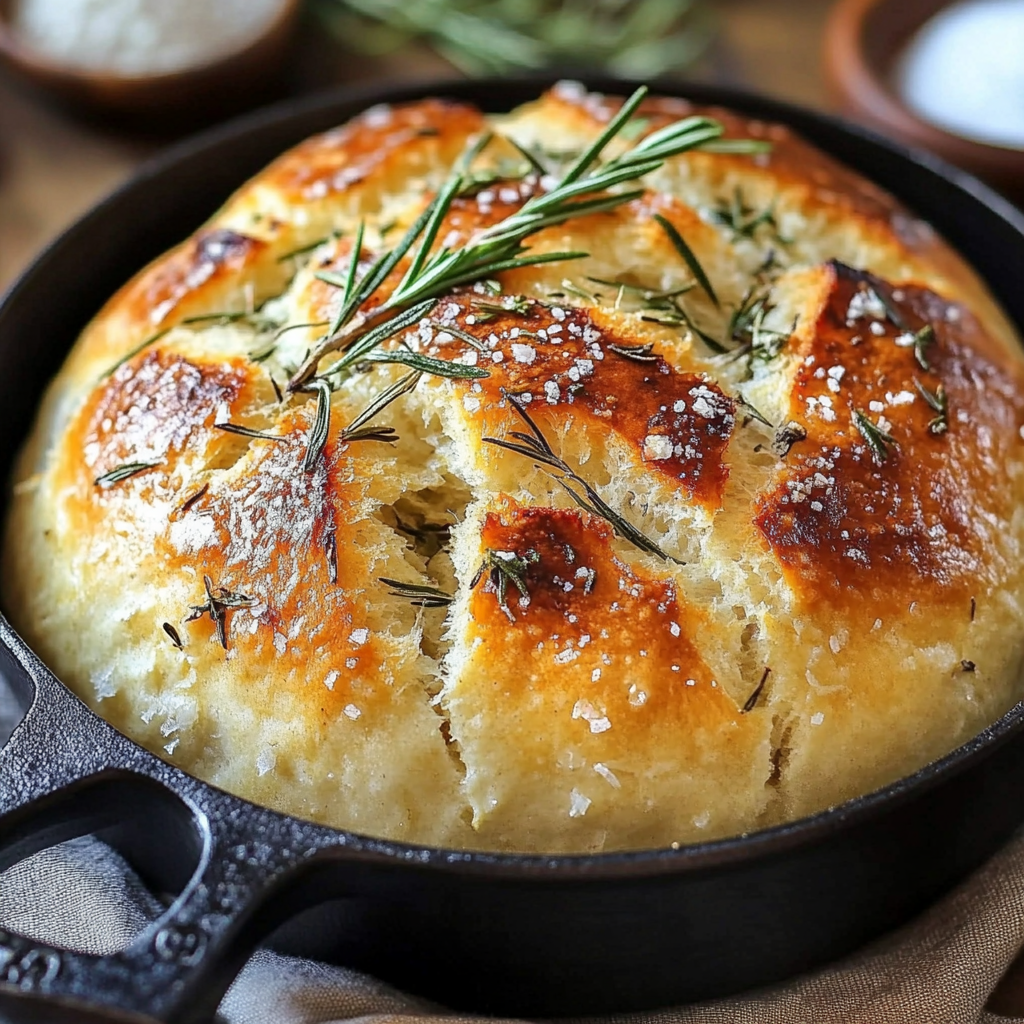Detailed Outline for “Rustic No Knead Rosemary Garlic Bread”
Introduction: Why Rustic No Knead Rosemary Garlic Bread is the Ultimate Comfort Food
- What makes no-knead bread special?: The simplicity and ease of making bread without the kneading process
- Rosemary and garlic flavors: A fragrant and savory combination
- The rustic charm of homemade bread: Why this style is perfect for any meal
- When to serve this bread: Ideal for family dinners, gatherings, or as a snack
The Key Ingredients for Rustic No Knead Rosemary Garlic Bread
- Flour: The base for your bread dough
- All-purpose flour or bread flour?
- Yeast: Essential for rising
- Active dry yeast vs. instant yeast
- Water and salt: The basic components for flavor and texture
- Why the right amount of water matters
- Olive oil: Adding richness and flavor
- Rosemary and garlic: Infusing the dough with fresh, aromatic flavors
- Optional additions: Customize your bread
- Parmesan cheese
- Crushed red pepper flakes for a kick
How to Make Rustic No Knead Rosemary Garlic Bread
- Step-by-step guide: The simplicity of no-knead bread
- Mixing the ingredients together
- Allowing the dough to rise
- Shaping the dough and baking it to perfection
- How long to let the dough rise: Timing for best results
- Baking tips: Getting the right crust and texture
- Using a Dutch oven or baking stone for a rustic crust
- How to achieve a soft, airy inside with a crunchy outside
Tips for Perfect Rustic No Knead Rosemary Garlic Bread
- Hydration of the dough: Getting the perfect consistency
- How to handle the dough: Shaping and transferring to the baking pot
- Adding garlic and rosemary: How to evenly distribute the flavors throughout the bread
- Storing the bread: How to keep it fresh and flavorful
Creative Variations of Rustic No Knead Rosemary Garlic Bread
- Herb variations: Trying thyme, oregano, or basil instead of rosemary
- Cheese additions: Adding cheddar or mozzarella for a cheesy twist
- Whole grain versions: Using whole wheat or spelt flour for a healthier option
- Sweet variations: Adding honey or dried fruit for a sweet twist
Serving and Pairing Ideas for Rustic No Knead Rosemary Garlic Bread
- Perfect for any meal: Pairing with soups, stews, or salads
- Great for dipping: Olive oil, balsamic vinegar, or flavored butters
- Perfect for cheese boards: Adding a rustic touch to a cheese platter
- Sandwich possibilities: Using the bread for hearty sandwiches or grilled cheese
Conclusion: Why Rustic No Knead Rosemary Garlic Bread is a Must-Try
- Easy, flavorful, and comforting: The appeal of homemade bread with minimal effort
- Versatile for many occasions: From casual dinners to special occasions
- The final word on rustic bread: A simple recipe that always delivers delicious results
FAQs
- Can I make this bread without a Dutch oven?
- How can I make the bread fluffier?
- Can I use fresh rosemary instead of dried?
- How do I know when the bread has finished baking?
- Can I freeze this no-knead bread?
- Can I use whole wheat flour for this recipe?
- How long will this bread last?
- Can I make this bread without garlic?
- How do I get a crispy crust without a Dutch oven?
- Can I make this recipe in advance?
Blog Post: Rustic No Knead Rosemary Garlic Bread
Introduction: Why Rustic No Knead Rosemary Garlic Bread is the Ultimate Comfort Food
Bread has long been a comfort food that brings warmth and joy to any table, but when it’s homemade, it takes that comfort to the next level. Rustic no knead rosemary garlic bread combines the simplicity of no-knead bread with the aromatic flavors of garlic and rosemary. This bread doesn’t require any special skills or equipment—just patience and a few basic ingredients.
The magic of no-knead bread is its ease. You can have fresh, crusty bread without spending hours in the kitchen kneading and shaping. And the best part? The rosemary and garlic flavors infuse the dough as it rises, creating a loaf that’s packed with savory, fragrant goodness.
Whether you’re preparing it for a family dinner, a casual get-together, or just because you’re craving homemade bread, this rustic rosemary garlic bread is sure to impress. It’s delicious, comforting, and perfect for any meal.
The Key Ingredients for Rustic No Knead Rosemary Garlic Bread
Making rustic no knead rosemary garlic bread requires just a handful of ingredients. Here’s a breakdown of what you’ll need to create this flavorful loaf:
Flour: The base for your bread dough
- All-purpose flour is a great option for this recipe. It creates a light, airy texture while still giving the bread enough structure. You can also experiment with bread flour for a slightly chewier texture.
Yeast: Essential for rising
- Active dry yeast or instant yeast will both work for this recipe. Instant yeast doesn’t need to be activated in warm water like active dry yeast, which makes it a bit faster, but either will do the job.
Water and salt: The basic components for flavor and texture
- The right amount of water is key to ensuring the dough is hydrated properly, creating that airy, rustic crumb. You’ll also need salt to enhance the flavors and balance the yeast.
Olive oil: Adding richness and flavor
- Olive oil is often used in rustic bread recipes for its richness. It helps the dough rise and adds flavor to the final loaf.
Rosemary and garlic: Infusing the dough with fresh, aromatic flavors
- Fresh rosemary adds a piney, earthy flavor that’s perfect for rustic bread. If fresh rosemary is not available, dried rosemary will work just fine.
- Garlic adds a rich depth of flavor. Whether you use roasted garlic or fresh garlic, it will complement the rosemary beautifully.
Optional additions: Customize your bread
- For extra flavor, you could add parmesan cheese to the dough, giving it a savory, cheesy richness.
- If you like a little heat, a sprinkle of crushed red pepper flakes will add a spicy kick to the bread.
How to Make Rustic No Knead Rosemary Garlic Bread
Making rustic no knead rosemary garlic bread is simple and rewarding. Here’s how to do it:
Step-by-step guide: The simplicity of no-knead bread
- Mix the ingredients: In a large bowl, combine the flour, yeast, salt, garlic, and rosemary. Add the water and olive oil and stir until the dough comes together. You’ll have a sticky dough—this is normal!
- Let the dough rise: Cover the bowl with plastic wrap or a clean towel and let it rise in a warm place for about 12-18 hours. The dough should double in size and become bubbly and slightly uneven in texture.
- Shape the dough: After the dough has risen, gently fold it over onto itself a few times. Turn the dough out onto a floured surface and shape it into a round loaf.
- Preheat the oven: Place a Dutch oven or heavy pot with a lid in your oven and preheat to 450°F (230°C). If you don’t have a Dutch oven, a baking stone will work too.
- Bake the bread: Carefully remove the hot pot from the oven, place the dough inside, cover, and bake for 30 minutes. Then, remove the lid and bake for another 10-15 minutes until the crust is golden and crispy.
- Cool and enjoy: Let the bread cool for at least 15 minutes before slicing.
How long to let the dough rise: Timing for best results
For the best flavor and texture, you’ll want to let the dough rise for 12-18 hours. This extended rise helps develop the complex flavors and gives the bread that airy, rustic texture.
Baking tips: Getting the right crust and texture
- Dutch oven method: Using a covered Dutch oven traps moisture, which creates a steamy environment, resulting in a crispy, golden crust. If you’re using a baking stone, consider adding a pan of water to the oven to mimic the effect.
Tips for Perfect Rustic No Knead Rosemary Garlic Bread
- Hydration of the dough: The dough should be wet and sticky but not too runny. If the dough feels too dry, add a bit more water, a tablespoon at a time.
- How to handle the dough: Handle the dough gently to maintain its air bubbles, which gives the bread a soft, open crumb.
- Adding garlic and rosemary: To evenly distribute the garlic and rosemary, mix them into the dry ingredients before adding the water. This helps them get evenly incorporated into the dough.
- Storing the bread: Keep the bread in a paper bag or wrapped in a kitchen towel to maintain its crust. It will stay fresh for a couple of days, or you can freeze it for longer storage.
Creative Variations of Rustic No Knead Rosemary Garlic Bread
- Herb variations:

